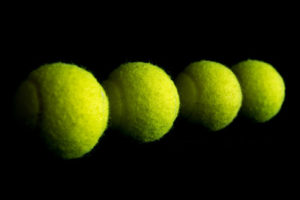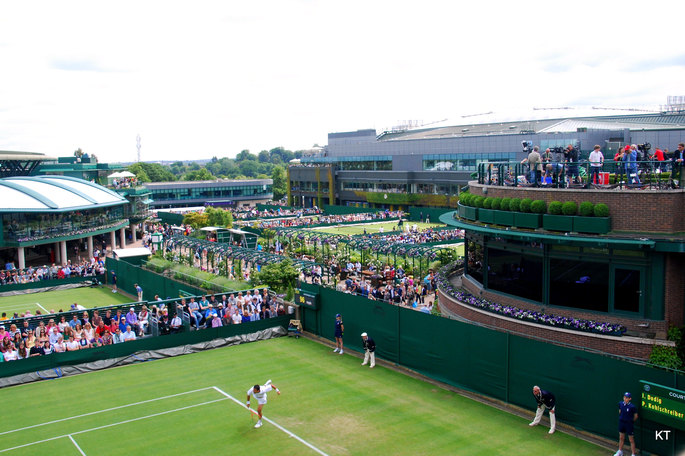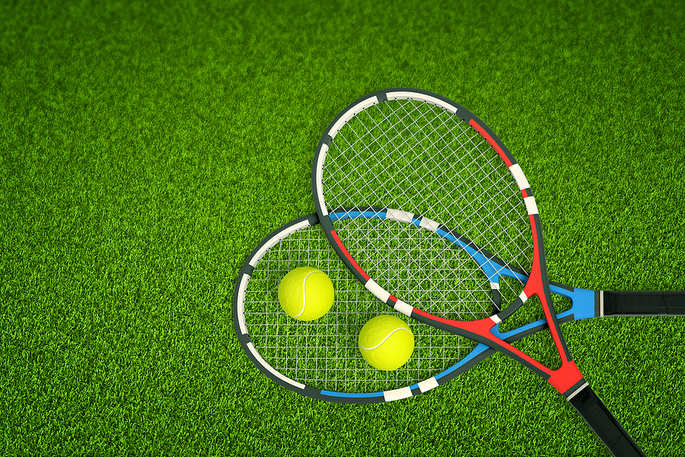 When it comes to the major tournaments in tennis, there are four main ones for players to aim for. English people will naturally assume that Wimbledon is at the top of the list, whilst the French will presume it’s the French Open and Americans will figure it’s the US Open. Australians are probably more realistic and know that their Open isn’t going to be seen as the top dog when up against the other three tournaments for men and women.
When it comes to the major tournaments in tennis, there are four main ones for players to aim for. English people will naturally assume that Wimbledon is at the top of the list, whilst the French will presume it’s the French Open and Americans will figure it’s the US Open. Australians are probably more realistic and know that their Open isn’t going to be seen as the top dog when up against the other three tournaments for men and women.
Regardless of which one anyone thinks is the best, the four of them together are the ones that players so desperately want to win. They’re spaced out fairly evenly through the year, meaning that players are able to try to win them during the same twelve month period if they’re in particularly good form. They are also played out on different surfaces, making the winning of them all a true sign of a player’s absolutely brilliance at the sport.
The Four Majors

By Carine06, flickr
You can read about the four Majors that make up the tennis Grand Slam in more detail elsewhere on this site, so here we’ll keep things relatively concise. Even so, it’s handy to outline quickly which four tournaments we’re talking about so that we’re all on the same page.
The four events that constitute the Grand Slam, the time of year that the tournaments take place, the location where the matches are played and the surface that they’re played on are as follows:
Tennis Grand Slam Tournaments
| Tournament | Month(s) Held | Host Venue | Surface |
|---|---|---|---|
| Australian Open | January | Melbourne Park, Melbourne, Australia | Hard Courts |
| French Open | May / June | Stade Roland Garros, Paris, France | Clay Courts |
| Wimbledon | June / July | All England Club, London, UK | Grass Courts |
| US Open | August / September | National Tennis Center, New York, USA | Hard Courts |
The Difference Between Calendar & Career Grand Slams

There are two types of Grand Slam that a player can win. The first is a Calendar Grand Slam, whilst the second is a Career Grand Slam. These are quite self-explanatory, but for the avoidance of doubt the easiest way to understand the difference is as follows:
- If a player wins all four tournaments in the same tennis season then they’ve won a Calendar Grand Slam
- If the player wins all four tournaments at some point in the career but in different tennis seasons then they’ve achieved a Career Grand Slam
Obviously a player that wins a Calendar Grand Slam has also technically won a Career Grand Slam, but they’re thought of as two separate and distinct things. Whilst a Calendar Grand Slam is obviously the tougher achievement, a Career Grand Slam is just as likely to be thought of as a phenomenal achievement. Some players have won the Grand Slam more than once or the Grand Slam once but individual tournaments more than once.
Calendar Grand Slam Winners
Let’s start by looking at the achievement which is technically the most impressive of the two, the Calendar Grand Slam. Below is the Male and Female players who have achieved this in the singles tournaments.
Male and Female Singles Calendar Grand Slam Winners
| Year | Player | Nationality |
|---|---|---|
| 1938* | Don Budge | USA |
| 1953* | Maureen Connolly | USA |
| 1962* | Rod Laver | Australia |
| 1969 | Rod Laver | Australia |
| 1970 | Margaret Court | Australia |
| 1988 | Steffi Graf | Germany |
The three occasions shown with an asterisk ,1938, 1953 and 1962, occurred before the open era, meaning that professional players did not take part. Rod Laver won calendar Grand Slams both as an amateur and a professional. The shortness of the list shows just how difficult it is to achieve such a feat, with some major names missing from it. We’ll come back to that later on.
Next we’ll look at the doubles players who have won a calendar Grand Slam.
Male and Female Doubles Calendar Grand Slam Winners
| Year | Players | Doubles Tournament |
|---|---|---|
| 1951 | Frank Sedgman and Ken McGregor | Men’s |
| 1960 | Maria Bueno (with Christine Truman & Darlene Hard) | Women’s |
| 1963 | Margaret Court and Ken Fletcher | Mixed |
| 1967 | Owen Davidson (with Lesley Turner & Billie Jean King) | Mixed |
| 1984 | Martina Navratilova and Pam Shriver | Women’s |
| 1998 | Martina Hingis (with Mirjana Lucic & Jana Novotna) | Women’s |
| 2009 | Esther Vergeer & Korie Homan | Women’s Wheelchair |
| 2011 | Esther Vergeer & Sharon Walraven | Women’s Wheelchair |
| 2013 | Aniek van Koot & Jiske Griffioen | Women’s Wheelchair |
| 2014 | Stephane Houdet (with Shingo Kunieda & Joachim Gerard) | Men’s Wheelchair |
| 2014 | Jordanne Whiley & Yuri Kamji | Women’s Wheelchair |
| 2019 | Aniek van Koot & Diede de Groot | Women’s Wheelchair |
| 2019 | Dylan Alcott (with H. Davidson, D. Wagner & A. Lapthorne) | Quad Wheelchair |
Whether you think that players who have won calendar Grand Slams in the various doubles disciplines is as great a feat as the singles will be a matter of personal opinion. That will be even more the case when the person won the matches with different partners during the year. They’ve been included in the table for completeness, so you can make your own mind up on that front.
Career Grand Slam Winners
Whilst it is no less impressive a feat to win a Grand Slam over the course of a career rather than the course of the season, they are looked at as two separate achievements. Here’s the table of people that have won a Grand Slam during their time playing tennis, even if they didn’t win all four tournaments during the same year, with the year in bold showing when that player completed their career Grand Slam.
Male and Female Singles Career Grand Slam Winners
| Player | 1st Australian Open | 1st French Open | 1st Wimbledon | 1st US Open |
|---|---|---|---|---|
| Fred Perry | 1934 | 1935 | 1934 | 1933 |
| Doris Hart | 1949 | 1950 | 1951 | 1954 |
| Shirley Fry Irvin | 1957 | 1951 | 1956 | 1956 |
| Roy Emerson | 1961 | 1963 | 1964 | 1961 |
| Billie Jean King | 1968 | 1972 | 1966 | 1967 |
| Chris Evert | 1982 | 1974 | 1974 | 1975 |
| Andre Agassi | 1995 | 1999 | 1992 | 1994 |
| Serena Williams | 2003 | 2002 | 2002 | 1999 |
| Roger Federer | 2004 | 2009 | 2003 | 2004 |
| Rafael Nadal | 2009 | 2005 | 2008 | 2010 |
| Maria Sharapova | 2008 | 2012 | 2004 | 2006 |
| Novak Djokovic | 2008 | 2016 | 2011 | 2011 |
Obviously many of the players in the table above won some of the tournaments more than once, but the years shown are when they won each of the competitions for the first time. Andre Agassis, for example, won three of the four Majors by 1995 but had to wait another four years to complete his Career Grand Slam.
It is worth noting that six of the twelve players won the French Open as their final Grand Slam and only Roy Emerson completed his career Grand Slam at Wimbledon.
As an aside, there is also another Grand Slam, known as the Golden Slam, which is for players that have won all of the Grand Slam events as well as a Gold medal during the Summer Olympics. The following players have achieved this playing Singles tennis:
- Steffi Graf (Olympic Gold in 1988)
- Andre Agassis (Olympic Gold in 1996)
- Rafael Nadal (Olympic Gold in 2008)
- Serena Williams (Olympic Gold in 2012)
Famous Players Who Have Never Won All Four Slams
The reason why a Career Grand Slam is given almost as much praise and attention as a Calendar Grand Slam is that they are really, really difficult to win. So difficult, in fact, that there are scored of phenomenally talented tennis players that have never managed to do it. They will have ended their careers having won some massive tournaments that will live with them forever, but they’ll have just missed out on the biggest prize of all.
Here’s a look at some of those players that are surprising for the absence from the Career Grand Slam list, along with the tournament that has somehow eluded them:
Career Slam Near Misses (Men’s & Women’s Singles)
| Player | Missing Major(s) | Best Performance |
|---|---|---|
| Jimmy Connors | French Open | Semi-finalist (1979, 1980, 1984, 1985) |
| Monica Seles | Wimbledon | Finalist (1992) |
| Martina Hingis | French Open | Finalist (1997, 1999) |
| Venus Williams | Australian Open | Finalist (2003, 2017) |
| French Open | Finalist (2002) | |
| Andy Murray | Australian Open | Finalist (2010, 2011, 2013, 2015, 2016) |
| French Open | Finalist (2016) |
It’s surprising to see some of the names on that list, not least of all because Andy Murray made the final of the French Open in 2016 and the Australian Open final in 2010, 2011, 2013, 2015 and 2016. Other players on the list also made the final of the major they missed out on at least once, only to come up short when it mattered. For Murray, he was unlucky to play in an era of dominance by Roger Federer, Novak Djokovic and Rafael Nadal.
